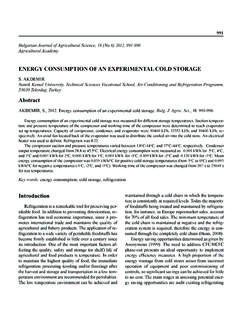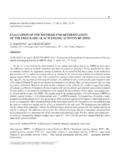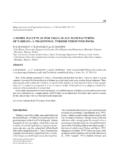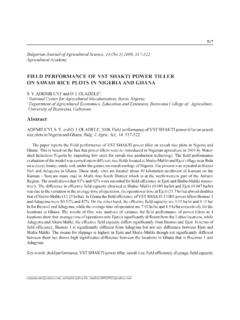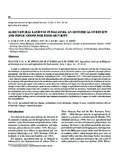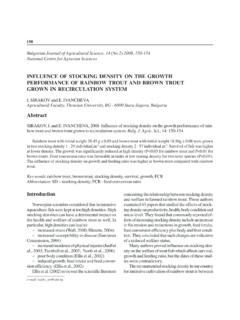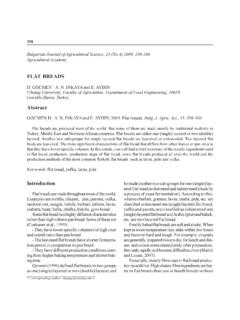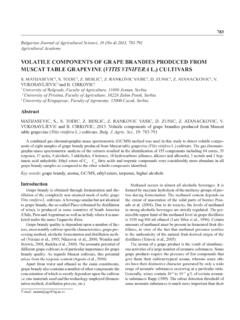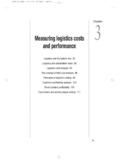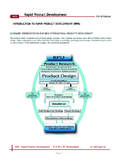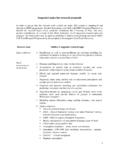Transcription of PINEAPPLE FARMERS’ INFORMATION SOURCES …
1 Bulgarian Journal of Agricultural Science, 14 (No 4) 2008, 381-389 Agricultural AcademyPINEAPPLE farmers INFORMATION SOURCES AND USAGEIN NIGERIAO. PIPY FAWOLED epartment of Agricultural Extension and Rural Development, University of Ibadan, NigeriaAbstractFAWOLE, O. PIPY, 2008. PINEAPPLE farmers INFORMATION SOURCES and usage in J. Agric. Sci., 14: 381-389 PINEAPPLE farmers access to and use of INFORMATION have great income generation potentials for farmers ,expansion of local industries and foreign exchange earnings for Nigeria. This study, thus investigated farmers INFORMATION SOURCES and usage. Interview schedule was used to collect data from 119 respondents which consti-tuted 27% of all PINEAPPLE farmers in the study area. Results show respondents were mostly male (60%),married (66%), with one form of education or another (X = , SD = ), and aged 28 years and above(71%).
2 Relationships exist between respondents selected personal characteristics and INFORMATION SOURCES andusage, years of farming and farming activities challenges. PINEAPPLE farmers will source and use informationfrom easily available and accessible SOURCES such as radio and newspaper. Improving the knowledge base offarmers will facilitate INFORMATION sharing amongst them. Research and extension should therefore developcontents in both radio and newspapers that will expand farmers knowledge base and practical skills for improvedpineapple words: PINEAPPLE farmers , INFORMATION SOURCES and Usage, Nigeriae-mail: and IntroductionUntil recently, about 80% of PINEAPPLE producedin Nigeria came from small scale farms managed un-der mixed cropping systems. Recent access to inter-national markets, enhanced local values of fresh fruits,resuscitation of PINEAPPLE cultivation, and local pro-cessing have encouraged the development of few largescale intensive managed farms where PINEAPPLE is pro-duced as a monocrop (Ucheagu, 1985).
3 Pineappleas an economic crop has encouraging potentials forforeign exchange earnings. It can also increase na-tional income through the expansion of local indus-tries and higher incomes for farmers involved in itsproduction. Current production figures show that Ni-geria is the 6th largest producer of PINEAPPLE in theworld and if current production and marketing trendsare encouraged, commercial production for export andlocal consumption will be enhanced (FAO/WorldBank, 1999).Enhancing agricultural production in Nigeria is of-ten linked to farmers access and use of agriculturalinformation. Idachaba (1980) noted the importanceof disseminating INFORMATION in forms easily understoodby farmers in improving production. Aina (1985)conducted an adoption study which suggested that381farmers adopt new farming technologies, if informa-tion of such technologies, is at their disposal.
4 Theseobservations expectedly have influenced government senlistment of INFORMATION in agricultural developmentin Nigeria. But in spite of efforts by government andextension at improving farmers access to agriculturalinformation, the export of agricultural products includ-ing PINEAPPLE has declined due to importation. Thishas led to poor and weak agricultural , PINEAPPLE and its products have be-come early as 1971, Lesley noted the enormous bodyof research based- INFORMATION in agriculture availablein research institutes and faculties of agriculture in uni-versities in Nigeria. Olayide and Ogunfowora (1981)examined the dynamics of agricultural production tech-nology under Nigerian condition, and revealed thatthere is a lag of about 50 years between the develop-ment of farm innovations from research and their ap-plication.
5 They concluded that the problem lies withthe dissemination and flow of INFORMATION to , Olowu (1990) claimed that numerousstudies identified various INFORMATION SOURCES to farm-ers but there is yet to be appreciable increase in agri-cultural production. This situation is also applicable topineapple production in Nigeria. PINEAPPLE farmers access to relevant INFORMATION is critical to increasedpineapple dissemination to PINEAPPLE farmers inthe rural areas is an integral part of the clamor foradoption of innovations and agricultural effectiveness of SOURCES and frequency of agri-cultural INFORMATION availability then become of para-mount importance, if any meaningful development isto be achieved. INFORMATION SOURCES may also havecontributory linkages to the utilization of INFORMATION ,essential in packaging and adapting INFORMATION forlocal , this study was structured to investi-gate the SOURCES and use of INFORMATION among pine-apple farmers in Nigeria.
6 The objectives guiding theinquiry were to:I. Determine the personal characteristics of pine-apple farmersII. Determine PINEAPPLE farmers awareness ofavailable INFORMATION on PINEAPPLE productionIII. Ascertain PINEAPPLE farmers SOURCES of agri-cultural informationIV. Determine PINEAPPLE farmers frequency of useof available informationV. Investigate PINEAPPLE farmers frequency of con-tact with extension agents andVI. Delineate farming challenges encountered bypineapple Local Government Area in Edo State waspurposively selected for the study based on two cri-teria: high concentration of PINEAPPLE growers in thearea and representativeness of a typical pineapplegrowing a list of PINEAPPLE growers compiled by thestaff of the agricultural unit of the local governmentarea, 120 farmers were randomly interview schedule with items based on theobjectives of the study was used to collect data fromthe selected farmers .
7 The interview schedule contained17 questions measuring: demographic characteristics INFORMATION awareness INFORMATION SOURCES INFORMATION usage contact with extension agents and constraints encountered in PINEAPPLE of VariablesFarmers were asked to indicate their age, sex,educational attainment, marital status, years of farm-ing production purpose, cultivated variety, capitalsource, marketing outlet, agrochemical input sourcesand awareness: farmers were asked to in-dicate whether or not they are aware of available pine-apple production INFORMATION . INFORMATION SOURCES : farmers were asked to indi-382O. Pipy FawoleFrequency/percentageN= ( )28-37 year43 ( )Male71 ( )Female48 ( )Single40 ( )Married79 ( )Christianity68 ( )Islam37 ( )Traditionalist12 ( )Others2 ( )No formal education22 ( )Adult Education26 ( )Primary Education20 ( )Secondary Education21 ( )Tertiary Education30 ( )1-5years52 ( )6-10years36 ( )11-15years20 ( )16 years and above11 ( )Less than I hectare43 ( )2-4 hectare54 ( )5 hectares and above22 ( )Personal Labour40 ( )Hired Labour41 ( )Communal Labour22 ( )Family labour16 ( )Smooth Cayenne62 ( )Queen42 ( )Ornamental11 ( )Profit making90 ( ( )Suckers69 ( )Crowns35 ( )Slips15 ( )Personal savings44 ( )Relatives30 ( )Bank loan20 ( )Cooperatives25 ( ))
8 1 Marital materials characteristics of respondents VariablesMeanCategoriesSD383 PINEAPPLE farmers INFORMATION SOURCES and Usage in Nigeriacate their INFORMATION source and frequency of infor-mation of indicated usage: farmers were asked to indicateon a 3-point scale the frequency of available informa-tion with extension agents: farmers were askedto indicate on a 3-point scale their frequency of con-tact with extension challenges: farmers were asked toreact to multiple choice statements indicating chal-lenges and inferential statistics were used toanalyze the data characteristics of farmers were ana-lyzed using percentages and relationships between selected variableswere established using chi-square results of this study are discussed accordingto the objectives of the data (Table 1) show that pineapplefarmers mean age is years.
9 They are mostlymale (60%) between the ages of 28-37 years (36%),married (66%), Christians (57%) with one form ofeducation or another ( ). This finding is consis-tent with previous studies focused on farmers in Ni-geria which revealed that agriculture is predominantlyin the hands of active middle aged farmers (Olowu etal., 1988). The results also indicate that the farmershave 1-5 years farming experience (43%), own be-tween 2 4 hectares of farmland (45%), use mainlypersonal savings (37%) and hired labour for pineappleproduction activities. The farmers inability to obtainloans may be due to the stiff loaning conditions ofbanks. On the other hand, their use of hired labourmay be linked with their planting of smooth cayennevariety using suckers. This is usually done manuallyand therefore labour intensive. This labour require-ment is of necessity met through hiring labour fromthe farmers results further indicate that the farmers mainpurpose of production is profit (75%) and villagemarkets are their major outlets (60%).
10 The use offertilizers among the farmers is widespread (59%)because they can afford to buy those (53%). Thesale of their products ( PINEAPPLE ) in village markets isconsistent with the poor rural infrastructural baseprevalent in Nigeria while their use of fertilizers re-flects the farmers profit-oriented production and edu-cational reaction to 12 PINEAPPLE production ac-tivities INFORMATION was designed to assess their aware-ness of production INFORMATION (Table 2). Data on384O. Pipy FawoleFrequency/percentageN=119 Village market72 ( )Urban market24 ( )Farm market23 ( )Herbicides21 ( )Fertilizers59 ( )Pesticides18 ( )Affordable64 ( )Relatively affordable38 ( )Not affordable17 ( )Input characteristics of respondents VariablesMeanCategoriesSDMarket types 1 continuedTable 2 show that between 64% - 78% of the farm-ers are aware of seven activities (planting materials,fertilizer application, harvesting, spacing, weeding,spraying and propagation); 51% - 55% are aware of4 activities (storage, mulching, transportation andmarketing); while 45% are aware of only one activity(processing INFORMATION ).
